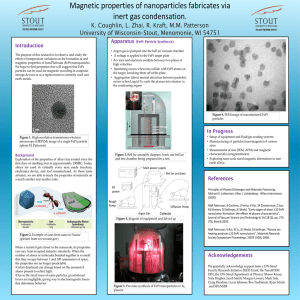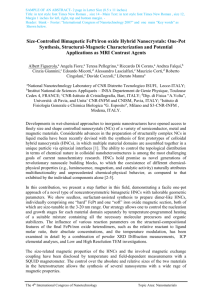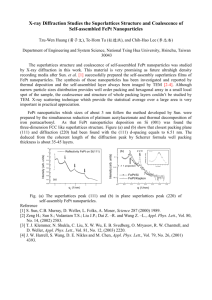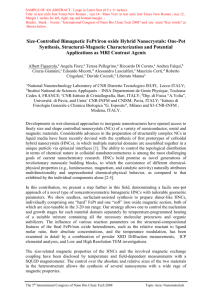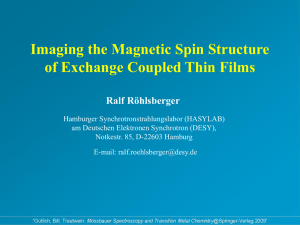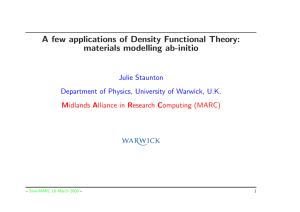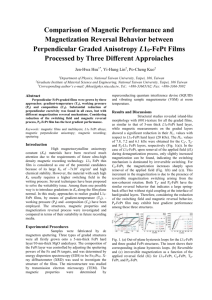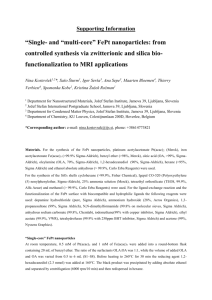Magnetic-field-induced crystallographic texture enhancement in cold
advertisement
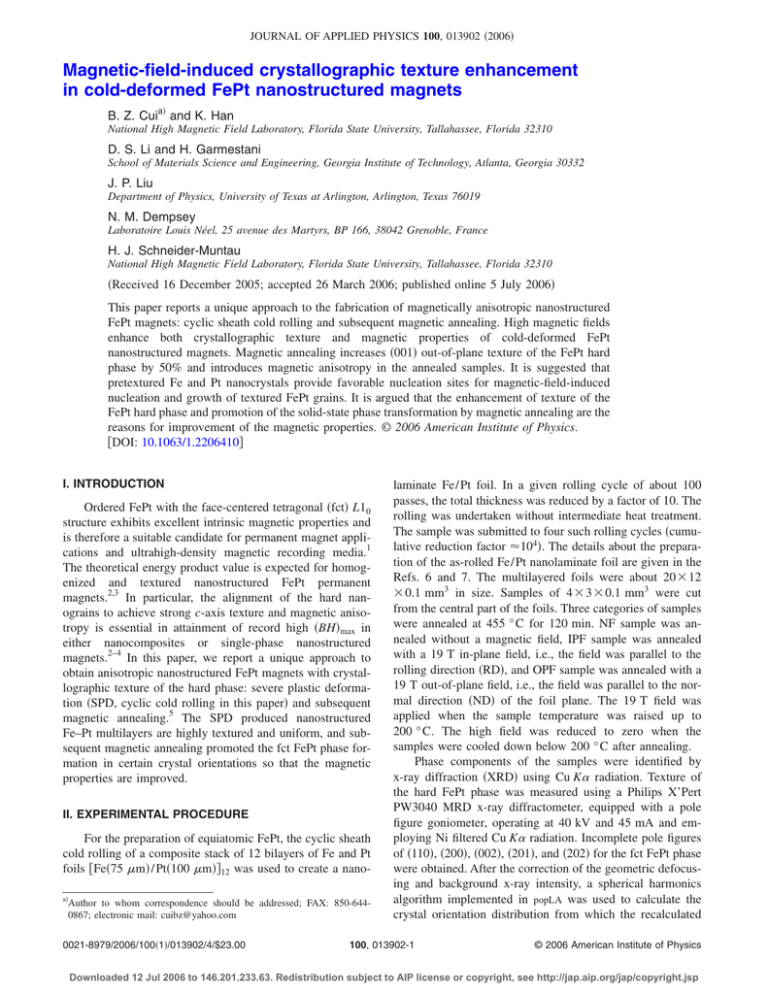
JOURNAL OF APPLIED PHYSICS 100, 013902 共2006兲 Magnetic-field-induced crystallographic texture enhancement in cold-deformed FePt nanostructured magnets B. Z. Cuia兲 and K. Han National High Magnetic Field Laboratory, Florida State University, Tallahassee, Florida 32310 D. S. Li and H. Garmestani School of Materials Science and Engineering, Georgia Institute of Technology, Atlanta, Georgia 30332 J. P. Liu Department of Physics, University of Texas at Arlington, Arlington, Texas 76019 N. M. Dempsey Laboratoire Louis Néel, 25 avenue des Martyrs, BP 166, 38042 Grenoble, France H. J. Schneider-Muntau National High Magnetic Field Laboratory, Florida State University, Tallahassee, Florida 32310 共Received 16 December 2005; accepted 26 March 2006; published online 5 July 2006兲 This paper reports a unique approach to the fabrication of magnetically anisotropic nanostructured FePt magnets: cyclic sheath cold rolling and subsequent magnetic annealing. High magnetic fields enhance both crystallographic texture and magnetic properties of cold-deformed FePt nanostructured magnets. Magnetic annealing increases 共001兲 out-of-plane texture of the FePt hard phase by 50% and introduces magnetic anisotropy in the annealed samples. It is suggested that pretextured Fe and Pt nanocrystals provide favorable nucleation sites for magnetic-field-induced nucleation and growth of textured FePt grains. It is argued that the enhancement of texture of the FePt hard phase and promotion of the solid-state phase transformation by magnetic annealing are the reasons for improvement of the magnetic properties. © 2006 American Institute of Physics. 关DOI: 10.1063/1.2206410兴 I. INTRODUCTION Ordered FePt with the face-centered tetragonal 共fct兲 L10 structure exhibits excellent intrinsic magnetic properties and is therefore a suitable candidate for permanent magnet applications and ultrahigh-density magnetic recording media.1 The theoretical energy product value is expected for homogenized and textured nanostructured FePt permanent magnets.2,3 In particular, the alignment of the hard nanograins to achieve strong c-axis texture and magnetic anisotropy is essential in attainment of record high 共BH兲max in either nanocomposites or single-phase nanostructured magnets.2–4 In this paper, we report a unique approach to obtain anisotropic nanostructured FePt magnets with crystallographic texture of the hard phase: severe plastic deformation 共SPD, cyclic cold rolling in this paper兲 and subsequent magnetic annealing.5 The SPD produced nanostructured Fe–Pt multilayers are highly textured and uniform, and subsequent magnetic annealing promoted the fct FePt phase formation in certain crystal orientations so that the magnetic properties are improved. II. EXPERIMENTAL PROCEDURE For the preparation of equiatomic FePt, the cyclic sheath cold rolling of a composite stack of 12 bilayers of Fe and Pt foils 关Fe共75 m兲 / Pt共100 m兲兴12 was used to create a nanoa兲 Author to whom correspondence should be addressed; FAX: 850-6440867; electronic mail: cuibz@yahoo.com 0021-8979/2006/100共1兲/013902/4/$23.00 laminate Fe/ Pt foil. In a given rolling cycle of about 100 passes, the total thickness was reduced by a factor of 10. The rolling was undertaken without intermediate heat treatment. The sample was submitted to four such rolling cycles 共cumulative reduction factor ⬇104兲. The details about the preparation of the as-rolled Fe/ Pt nanolaminate foil are given in the Refs. 6 and 7. The multilayered foils were about 20⫻ 12 ⫻ 0.1 mm3 in size. Samples of 4 ⫻ 3 ⫻ 0.1 mm3 were cut from the central part of the foils. Three categories of samples were annealed at 455 ° C for 120 min. NF sample was annealed without a magnetic field, IPF sample was annealed with a 19 T in-plane field, i.e., the field was parallel to the rolling direction 共RD兲, and OPF sample was annealed with a 19 T out-of-plane field, i.e., the field was parallel to the normal direction 共ND兲 of the foil plane. The 19 T field was applied when the sample temperature was raised up to 200 ° C. The high field was reduced to zero when the samples were cooled down below 200 ° C after annealing. Phase components of the samples were identified by x-ray diffraction 共XRD兲 using Cu K␣ radiation. Texture of the hard FePt phase was measured using a Philips X’Pert PW3040 MRD x-ray diffractometer, equipped with a pole figure goniometer, operating at 40 kV and 45 mA and employing Ni filtered Cu K␣ radiation. Incomplete pole figures of 共110兲, 共200兲, 共002兲, 共201兲, and 共202兲 for the fct FePt phase were obtained. After the correction of the geometric defocusing and background x-ray intensity, a spherical harmonics algorithm implemented in popLA was used to calculate the crystal orientation distribution from which the recalculated 100, 013902-1 © 2006 American Institute of Physics Downloaded 12 Jul 2006 to 146.201.233.63. Redistribution subject to AIP license or copyright, see http://jap.aip.org/jap/copyright.jsp 013902-2 Cui et al. FIG. 1. XRD patterns of the FePt foils annealed at 455 ° C for 120 min 共a兲 without a field, 共b兲 with a 19 T in-plane field, 共c兲 with a 19 T out-of-plane field. XRD pattern of the as-rolled Fe/ Pt is also given in Fig. 1. pole figures were constructed.8 The error in normalized intensities of the texture components is smaller than 0.05 times random. The magnetic properties at 5 K were measured using a Quantum Design superconducting quantum interference device 共SQUID兲 magnetometer in fields up to 7 T. III. RESULTS AND DISCUSSIONS Scanning electron microscopy images of the as-rolled Fe/ Pt multilayered foil showed that the individual layer thickness after four deformation cycles was of the order of several tens of nanometers, in agreement with the bulk reduction factor.6,7,9 XRD investigations demonstrated that the Fe and Pt nanocrystals have 共001兲 and 共011兲 out-of-plane textures in the as-rolled foil, respectively.6,7 Therefore, the orientation relationship is 共001兲Fe 储 共011兲Pt,9 which is different from the orientation relationship observed in the Fe/ Pt multilayers prepared by sputter deposition.10 Annealing the Fe/ Pt multilayered foils at 455 ° C for 120 min leads to the formation of nanostructured fct FePt hard phase, accompanied by a small amount of the antiferromagnetic FePt3 phase 共see Fig. 1兲. The average grain size of fct FePt phase is 20 nm in this work, calculated from the 共002兲 diffraction peak using the Scherrer formula. Previous studies indicate that the grain sizes vary from tens of nanometers to a few hundreds of nanometers.6,7 It is noted that intensities of the 共001兲 and 共002兲 diffraction peaks of the FePt hard phase increase after magnetic annealing in a 19 T out-of-plane field. This is manifested by comparison of the 共200兲 diffraction peak with the 共002兲 one. The I002 / I200 values of the FePt hard phase are 1.0, 0.98, and 1.56 for the NF, IPF, and OPF samples, respectively, where I002 and I200 are the integrated intensities of 共002兲 and 共200兲 diffraction J. Appl. Phys. 100, 013902 共2006兲 FIG. 3. Distribution of c axes of the FePt crystals tilted away from the normal direction of the foil plane for the three samples of Fig. 2. peaks. The annealing with a 19 T out-of-plane field 共OPF sample兲 results in the greatest I002 / I200 among all the samples. This indicates that there is an obvious enhancement of the 共001兲 out-of-plane texture of the FePt hard phase in the OPF sample, whereas the I002 / I200 values for the NF and IPF samples are only marginally different, within the error bar of 5%. It should be noted that the I002 / I200 value for randomly oriented fct FePt powder is only 0.52, obtained from JCPDS 43-1359.11 This suggests that there is a 共001兲 out-of-plane texture of the FePt hard phase in all the annealed samples. The texture of the FePt hard phase was further evaluated by pole figures. Figure 2 shows recalculated 共001兲 pole figures of the FePt hard phase of the NF, IPF, and OPF samples. Figure 3 shows the quantitative distribution of c axes of the FePt crystals tilted away from the normal direction of the foil plane for the three samples of Fig. 2. It is obtained from the integration of the pole figures shown in Fig. 2 along the azimuthal direction. As shown in Figs. 2共a兲 and 3, in the NF sample 共which was annealed without a field兲, the distribution intensity of crystal c axes parallel to the ND is 2.4 times random. This indicates that the NF sample has a preferential orientation of c axes 共easy magnetization axis兲 of the FePt phase parallel to the ND, i.e., the FePt phase in this sample is 共001兲 out-of-plane textured. This corresponds to an orientation relationship of 共001兲Fe 储 共001兲FePt 储 共011兲Pt. The formation of this texture of the FePt phase is attributed to the cold-rolling-induced textures in both Fe and Pt phases. It can be deduced that the FePt nucleated to adapt the 共001兲Fe 储 共011兲Pt orientation relationship. The other important factor is the preferred nucleation sites. The formation of FePt 共fct兲 in the as-rolled nanolaminate Fe/ Pt foil should occur at interfaces of Fe and Pt at 455 ° C. The pretextured Fe and Pt induces the fct FePt grains with preferred crystallographic orientation as a result FIG. 2. 共001兲 pole figures of the FePt hard phase in the FePt alloys annealed at 455 ° C for 120 min 共a兲 without a field, 共b兲 with a 19 T in-plane field, and 共c兲 with a 19 T out-of-plane field. Note: TD is the transverse direction, while the crosshair corresponds to the ND of the sample. Downloaded 12 Jul 2006 to 146.201.233.63. Redistribution subject to AIP license or copyright, see http://jap.aip.org/jap/copyright.jsp 013902-3 J. Appl. Phys. 100, 013902 共2006兲 Cui et al. of defined habit plane for the nucleation and orientation relationship among Fe, Pt nanocrystals, and fct FePt phases. If the fct FePt phase nucleates on 共001兲Fe and 具100典FePt is parallel to 具110典Pt, the lattice mismatch is 5%. All other orientation relationships introduce more misfits in the system. Similarly, when the fct FePt phase nucleates with 共001兲FePt 储 共011兲Pt and 具100典FePt 储 具100典Pt, the misfit is merely 2%. Therefore, minimization of the misfit interface energy controls the nucleation and growth of fct FePt phase in the NF sample. Magnetic annealing influences the distribution of the c axes of the FePt nanocrystals. As shown in Figs. 2 and 3, compared with the sample annealed without a field, the distribution intensity of c axes of the FePt crystals along the ND increases by 50% 共from 2.4 to 3.6 times random兲 in the sample annealed with a 19 T out-of-plane field, which is still the strongest texture component. The value in the sample annealed with a 19 T in-plane field is the same as that of the sample annealed without a field. This indicates that the external field of 19 T is only strong enough to reorientate the grains to less than 90°. On the other hand, the distribution intensity of c axes of the FePt crystals in the foil plane increases from 0.97 to 1.4 times random in the IPF sample, as shown in Fig. 3. The intensity of texture component with c axes of the FePt crystals parallel to the RD increases from 0.2 to 2.7 times random, as shown in Fig. 2. Therefore, it can be seen that compared with the sample annealed without a field, there is a preferential orientation trend of c axes of the FePt nanocrystallites along the magnetic-field direction in the magnetically annealed samples. The magnetic annealing temperature in this work 共455 ° C兲 is lower than the Curie temperature of the FePt hard phase 共477 ° C兲.12 In the magnetic-field-assisted phase transformation, the driving force due to the magnetocrystalline anisotropy energy of ferromagnetic FePt phase could overcome the energy barriers associated with the shape anisotropy and the thermal disordering, if the applied magnetic field is high enough.13 In this case, the hard-phase-textured nanostructure with the easy axes parallel to the external field has lower free energy than a random structure, and therefore could be preferably formed. Therefore, the growth of textured FePt phase is attributed to both the texture inheritance from the pretextured Fe and Pt nanocrystals that provides favorable nucleation sites and magnetic-field-induced texture. The hysteresis curves of the annealed FePt samples measured with applied fields parallel and perpendicular to the foil plane are termed as in-plane 共IP兲 and out-of-plane 共OP兲 hysteresis curves in this paper, respectively. Figure 4 shows typical low field portions of half hysteresis loops of the NF and OPF samples. The magnetic results of all the samples are shown in Table I. Magnetically anisotropic behavior was clearly found in all the annealed samples, resulting from the textures of the FePt phase discussed above. Compared with the sample annealed without a field, magnetically annealed samples demonstrate an improvement in remanence Jr, and energy product 共BH兲max. 共BH兲max was increased by 18%– 19%. The highest 共BH兲max of 90.7 kJ/ m3 and Jr of 0.82 T from the OP hysteresis curves were obtained in the OPF FIG. 4. Hysteresis loops of FePt samples annealed at 455 ° C for 120 min 共a兲 without and 共b兲 with a 19 T out-of-plane 共N is the demagnetization factor兲. sample, which has the strongest 共001兲 out-of-plane texture. In the case of in-plane measurements, the IPF sample has the highest 共BH兲max and Jr because of its strongest 共001兲 inplane texture. In addition, the 共BH兲max and Jr from the OP hysteresis curves are higher than those from the IP ones because the 共001兲 out-of-plane texture is dominant in all the samples, as shown in Figs. 2 and 3. In our previous work, the as-rolled Fe/ Pt nanolaminate foils were also annealed at temperatures ranging from 500 to 1010 ° C for 20– 210 min with and without a 19 T field, which is above the Curie temperature of the FePt hard phase.14 Similar nanostructural, textural, and magnetic results were obtained for these FePt samples as those of the TABLE I. Magnetic properties of the three samples of Fig. 2. Error bars for 0Hc, Jr, and 共BH兲max are 0.5%, 0.5%, and 1%, respectively. Note: N is the demagnetization factor. From the IP hysteresis curves with N = 0 Samples NF 共without a field兲 IPF 共19 T inplane field兲 OPF 共19 T outof-plane field兲 From the OP hysteresis curves with N = 1 0H c 共T兲 共BH兲max 共kJ/ m3兲 Jr 共T兲 0H c 共T兲 0.89 52.5 0.59 0.82 76.5 0.76 0.9 61.9 0.65 0.87 81.2 0.79 0.93 58.7 0.64 0.81 90.7 0.82 共BH兲max 共kJ/ m3兲 Jr 共T兲 Downloaded 12 Jul 2006 to 146.201.233.63. Redistribution subject to AIP license or copyright, see http://jap.aip.org/jap/copyright.jsp 013902-4 J. Appl. Phys. 100, 013902 共2006兲 Cui et al. samples annealed at 455 ° C for 120 min in this paper.14 On the other hand, both high annealing temperature and long annealing time benefit completion of the diffusion of Fe and Pt atoms and the ordering phase transformation to completely form fct FePt, and further, decrease the relative volume fraction of FePt3 phase in the annealed FePt sample. Especially, a single fct FePt phase was obtained in the FePt sample annealed at 1010 ° C for 20 min.14 However, the grain growth of the fct phase and the decrease of the domain wall energy associated with pinning sites lead to a monotonous decrease of the coercivity and/or energy product of the FePt samples with increasing the annealing temperature or the annealing time.14 It should be noted that magnetic annealing does not only enhance the texture of the FePt hard phase but also accelerates the nucleation rate of ferromagnetic grains.15–17 The improvement in the magnetic properties is a comprehensive result of the magnetic-field-induced enhancement of crystallographic textures of the fct FePt phase and the promotion of the solid-state phase transformation through an increase of nucleation rate of the ordered FePt phase by magnetic annealing.15–17 On the other hand, compared with cyclic cold rolling, much stronger and different kinds of pretextures of Fe and Pt may be formed by other SPD methods, such as cyclic cold drawing, equal channel angular extrusion, high pressure torsion, etc.5 Further improvements of crystallographic textures and magnetic properties are expected by optimizing the SPD and magnetic annealing conditions. Thus, severe plastic deformation plus subsequent magnetic annealing offers a promising approach to the fabrication of bulk anisotropic nanostructured magnets. Further work on this issue is underway. ACKNOWLEDGMENT This work was supported by DARPA under Grant No. DAAD19-03-1-0038. One of the authors 共B. Z. Cui兲 thanks the assistance of F. Ingwiller 共Grenoble, France兲 in the sample preparation. 1 O. A. Ivanov, L. V. Solina, V. A. Demishima, and L. M. Magat, Phys. Met. Metallogr. 35, 81 共1973兲. 2 R. Skomski and J. M. D. Coey, Phys. Rev. B 48, 15812 共1993兲. 3 R. F. Sabiryanov and S. S. Jaswal, J. Magn. Magn. Mater. 177–181, 989 共1998兲. 4 T. Schrefl, J. Fiddler, and H. Kronmüller, Phys. Rev. B 49, 6100 共1994兲. 5 T. C. Lowe and R. Z. Valiev, Investigations and Applications of Severe Plastic Deformation 共Kluwer Academic, the Netherlands, 2000兲. 6 N. H. Hai, N. M. Dempsey, M. Veron, M. Verdier, and D. Givord, J. Magn. Magn. Mater. 257, L139 共2003兲. 7 N. H. Hai, N. M. Dempsey, and D. Givord, J. Magn. Magn. Mater. 262, 353 共2003兲. 8 D. Li, H. Garmestani, S. R. Kalidindi, and R. Alamo, Polymer 42, 4903 共2001兲. 9 M. Verdier, M. Veron, F. Bley, F. Ingwiller, N. M. Dempsey, and D. Givord, Philos. Mag. 85, 3157 共2005兲. 10 K. Han, K. Yu-Zhang, H. Kung, J. D. Embury, B. J. Daniels, and B. M. Clemens, Philos. Mag. A 82, 1633 共2002兲. 11 PCPDFWIN version 2.02, copyright © 1999 by JCPDS-ICDD. 12 T. Klemmer, D. Hoydick, H. Okumura, B. Zhang, and W. A. Soffa, Scr. Metall. Mater. 33, 1793 共1995兲. 13 P. Courtois, R. P. de la Bâthie, and R. Tournier, J. Magn. Magn. Mater. 153, 224 共1996兲. 14 B. Z. Cui, K. Han, H. Garmestani, and H. J. Schneider-Muntau, J. Appl. Phys. 99, 08E910 共2006兲. 15 B. Z. Cui, K. Han, H. Garmestani, J. H. Su, H. Schneider-Muntau, and J. P. Liu, Acta Mater. 53, 4155 共2005兲. 16 X. J. Hao, H. Ohtsuka, and H. Wada, Proceedings of the International Workshop on Materials Analysis and Processing in Magnetic Fields 共World Scientific, Singapore, 2005兲, p. 41. 17 B. Z. Cui, C. T. Yu, K. Han, J. P. Liu, H. Garmestani, M. J. Pechan, and H. J. Schneider-Muntau, J. Appl. Phys. 97, 10F308 共2005兲. Downloaded 12 Jul 2006 to 146.201.233.63. Redistribution subject to AIP license or copyright, see http://jap.aip.org/jap/copyright.jsp
